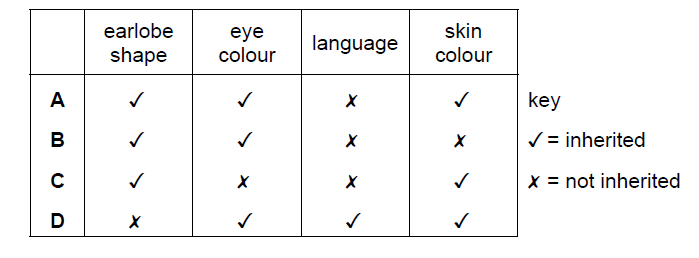Question
Which human characteristic is an example of discontinuous variation?
A height
B skin colour
C tongue rolling
D weight
 Answer/Explanation
Answer/Explanation
C
Tongue rolling is an example of a human characteristic that exhibits discontinuous variation. Tongue rolling refers to the ability to roll the tongue into a tube shape. It is a trait that can either be present or absent, with individuals either being able to roll their tongues or unable to do so. This trait does not exhibit a gradual range of variation but rather falls into distinct categories, making it an example of a trait with discontinuous variation.
On the other hand, height, skin color, and weight are examples of human characteristics that exhibit continuous variation. These traits show a range of variation with individuals falling along a spectrum rather than being limited to distinct categories.
Question
Which human characteristics are inherited?

 Answer/Explanation
Answer/Explanation
A
Ear lobe shape, eye color, and skin color are all human characteristics that can be inherited.
Ear lobe shape refers to the appearance of the lower part of the ear, which can either be attached directly to the side of the head (known as attached or unattached ear lobes) or hang freely (known as free or detached ear lobes). The shape of ear lobes is determined by genetic factors and is inherited from parents to offspring.
Eye color is determined by the pigmentation of the iris, the colored part of the eye. The variation in eye color, such as blue, green, brown, or gray, is mainly attributed to the amount and distribution of melanin, a pigment that gives color to the iris. Eye color is inherited and depends on multiple genes inherited from both parents.
Skin color is primarily determined by the amount of melanin in the skin. Melanin is produced by specialized cells called melanocytes and serves to protect the skin from harmful ultraviolet (UV) radiation. The amount and type of melanin produced by melanocytes vary among individuals and contribute to different skin colors, ranging from very light to very dark. Skin color is influenced by genetic factors, including multiple genes and their interaction with environmental factors like sun exposure.
Question
Which definition of continuous variation is correct?
A variation that results in a limited number of phenotypes between two extremes
B variation that results in a limited number of phenotypes with no intermediates
C variation that results in a range of phenotypes between two extremes
D variation that results in a range of phenotypes with no intermediates
 Answer/Explanation
Answer/Explanation
C
The correct definition of continuous variation is option C: “variation that results in a range of phenotypes between two extremes.” Continuous variation refers to a type of variation in which there is a gradual and uninterrupted spectrum of phenotypes between two extremes. It implies that there are no distinct or discrete categories or intermediates, but rather a continuum of possible variations. This type of variation is often influenced by multiple genes and environmental factors, resulting in a wide range of phenotypic expressions within a population.
Question
The following features were observed in a pair of identical twins.

Which features show phenotypic variation?
A eye colour and weight
B lobed ears and hair length
C tongue rolling and lobed ears
D weight and hair length
 Answer/Explanation
Answer/Explanation
D
The features that show phenotypic variation in a pair of identical twins are:
D) weight and hair length.
Identical twins are derived from a single fertilized egg that splits into two embryos. Since they share the same DNA, many physical traits, such as eye color and tongue rolling, are usually identical between them. However, traits such as weight and hair length can vary due to environmental factors, lifestyle choices, and other non-genetic influences. Therefore, these features can exhibit phenotypic variation even in identical twins.
Question
Which types of variation can be inherited?

 Answer/Explanation
Answer/Explanation
B
Variations caused by genes can be inherited. Genes are segments of DNA that contain instructions for the development and functioning of organisms. They determine various traits, such as physical characteristics, behavior, and susceptibility to certain diseases.
When organisms reproduce, they pass on their genetic information to their offspring. This inheritance can result in the transmission of genetic variations from one generation to the next. Genetic variations can arise through different mechanisms, such as genetic mutations or recombination during the formation of reproductive cells (gametes).
Inherited genetic variations can lead to observable differences among individuals, such as variations in eye color, height, or blood type. They can also contribute to the risk of developing certain diseases or conditions. For example, inheriting specific genetic variations can increase the likelihood of developing conditions like cystic fibrosis, sickle cell anemia, or certain types of cancer.
